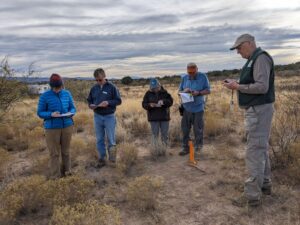
Friends of the Forest volunteers learning how to use paper maps and traditional compass to navigate hiking trails. Photo courtesy of Carol Dores.
Advanced planning is vital for hikes, regardless of the planned duration, difficulty, or your level of hiking experience. Here are some tips and techniques to help successfully and safely navigate hiking trails.
Before hitting the trail, thorough research and planning can make a significant difference. Familiarize yourself with the trail map, elevation, difficulty level, and any potential hazards, especially water crossings. The Red Rock Ranger District Visitor Center on Route 179 has a wealth of resources and they can help you choose the right destination.
Make sure to equip yourself with the right gear for the journey. A reliable map and compass are essential tools for navigation, even in this digital age. Many hikers have come to rely on navigation apps during hikes. It is easy to download an app and trail map before heading out and they are easy to follow. That is until they lead to a non-existent trail or to the wrong place. Unfortunately, this happens more often than expected, including here in Sedona. Consider carrying a GPS device or smartphone with a hiking app for real-time tracking, and bring an extra battery. CalTopo is the App that the Verde Search and Rescue uses, because of its reliability and capabilities.
Ensure your gear is in good condition, including a comfortable backpack, sturdy footwear, and appropriate clothing for the weather. Having extra water and food is essential. It is also useful to carry a space bag or large trash bag that can be used for insulation if stuck out longer than planned. Having a whistle, flashlight, signal mirror, knife, water container and purifier and first aid kit are also important.
“The deadliest hike is a day hike. People don’t carry what is needed if something goes wrong,” said Peg Kern, Verde Search and Rescue volunteer. “Carry an external battery backup. Your phone is your lifeline if you become injured or lost. With GPS coordinates on the phone, you can be found more quickly.”
Begin your hike by taking note of the trailhead features. Memorize landmarks, parking areas, and any notable signs that will help you recognize the starting point when returning. Mark where the hike starts on your phone, and turn on “record my tracks”, so the route is recorded. Snap a photo of the trailhead map if available, providing a quick reference during your hike.
Stick to marked trails to minimize your impact on the environment and avoid unnecessary complications. Straying off the designated path not only risks damaging the ecosystem but also increases the likelihood of getting lost. If you need to leave the trail for any reason, mark your departure point to make it easier to find your way back.
Develop basic orientation skills to stay aware of your surroundings. Periodically check the map and compare it to the things you see on and off the trail. Note distinctive landmarks, such as rock formations, water bodies, or unique trees, to maintain a mental map of your progress.
“There are about 80 Search and Rescue calls in the Verde Valley area a year. Many of these are from lost hikers, often because it is difficult to follow a trail back at night. They have no light or navigation abilities,” shared Tim Anderson, Captain of Verde Search and Rescue.
Recently, Verde Search and Rescue held an Orienteering class for Friends of the Forest Trail Patrol volunteers. Twenty-four Trail Patrol volunteers are now able to use an old-fashioned compass and map to navigate across any land. This skill will enhance their ability to help hikers on Sedona trails.
Lastly, hiking with a companion enhances safety and provides an extra set of eyes for navigation. Discuss the route together, share responsibilities, and communicate regularly to ensure both hikers are on the same page.
Navigating hiking trails is an art that combines preparation, awareness, and a deep connection with nature. By investing time in research, acquiring the right gear, and honing your navigation skills, you can embark on your hiking adventures with confidence. Remember, the journey is as important as the destination, and mastering the trails opens up a world of exploration and discovery in the great outdoors.
Want more information about volunteer opportunities with the Friends of the Forest? Visit www.friendsoftheforestsedona.org.
Serving Sedona, written this week by Carol Dores, Friends of the Forest, appears Wednesday in the Sedona Red Rock News.